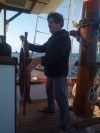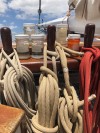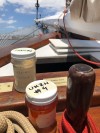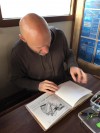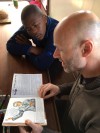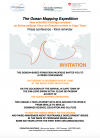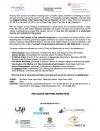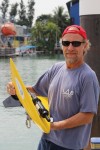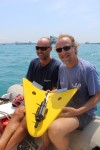- Home
- The expedition
- Around the world
- Programmes
-
- Socio-educational
- Youth at sea
- News
-
- Multimedia
All News
- Details
- Category: Scientific News
Dr David Glassom from KwaZulu-Natal University was on board Fleur de Passion from Durban to Knysna in November 2018 in the frame of his research on the use of plastic debris by juvenile fish as potential for species migrations or invasions in a time of global change. We met him in Durban in early October when the expedition was invited to participate in a two-day workshop organized by the South African Institute on Environmental Health, with the support of the embassy of Switzerland. And very soon, it appeared that the rest of journey along the West coast of South Africa towards Cape Town would be an interesting opportunity for him to explore further the phenomenon.
As Dr Glassom explains, « the potential of flotsam as vectors for long-distance migration for a variety of sessile organisms is well established. However, there is far less information on fish. Juvenile fish are known to shelter under plastic debris and a number of species have been recorded under debris in waters off Durban using a simple scoop net. Species range shifts or range expansions are already evident as a consequence of rising sea surface temperature due to global warming, and migrations could be facilitated by the availability of debris for shelter and possible nutrition from biofilms growing on the plastic. »
But before he can share initial results, let’s join David on board Fleur de Passion to experiment through his own words his « first trip on a large sailing vessel and one of (his) greatest experiences ».
« I was a bit nervous, as I am known to get seasick at times. But I took tablets for the entire journey and they worked – I felt no sickness at all. Travelling under sail was unique – the motion is completely different from being under engine power. Raising the sails, tacking the ship (no winches or mod-cons, just pulling on the ropes), was like living a boyhood fantasy. Although Pietro (skipper) did not assign me to specific shifts (my main job was cook’s assistant), I did link up with Candy (second mate and scientific coordinator) and Francois (passenger from Geneva) and tried to join their shifts at the helm. Learning to steer the Fleur was quite a steep curve – the first time I tried it, the rest of the crew must have been very confused, we were doing a zig-zag pattern while I tried to figure out the way the ship would respond. Steering under sail for the first time was a whole new learning curve, as keeping the right angle to get the wind in the sails was a bit of a challenge.
The accommodation was comfortable (the boat wasn’t full, so I had a cabin to myself). The food, compliments mainly of Pierre (cook) was fantastic and I found the entire crew really friendly and hospitable, not to mention professional and, even without any sailing experience I could see that they were highly competent. It was great especially to learn the history of the Foundation Pacifique from Pietro, who, it turns out, helped someone I know do research on whales many years ago. Communication was a bit of a problem; most of the crew spoke English, but a few didn’t and my French is non-existent – I did pick up a few words and phrases along the way.
Between Durban and East London, we were a bit far offshore to really see the coast, but from then on we were in view of the coast most of the time. I have never seen that part of the coast from the sea before, so that was also a new experience for me. The last part of the trip was really special – we were close to the coast and the cliffs between Plettenberg Bay and Knysna are really spectacular. Going through the entrance to Knysna lagoon (known as the Knysna Heads), was a bit nerve-wracking, with cliffs on one side, breaking surf on the other and a narrow channel that is just deep enough for the draft of the Fleur. A friendly guy from the National Sea Rescue Institute (NSRI) gave us some helpful guidance.
We had to periods of sitting at anchor, for a couple of days each – once in the estuary at East London and once in the sea off Plettenberg Bay. These times were a bit frustrating, but made as pleasant as possible by a bit of wildlife / bird watching and they gave me the chance to do some sampling for plastic close to shore. »
At Knysna in late November 2018, David had to leave the boat due his need to back in office. But while on board, he had briefed the crew so that more samplings could be made until Cape Town.
- Details
- Category: Cultural News
It is a great honor for the expedition. The comics artist Anton Kannenmeyer, one of the most talented author in his art in South African and internationally renown, recently embarked onboard Fleur de Passion for a few days. Born and raised in Cape Town and also known as Joe Dog, he is one of the co-founders in 1992 of Bittercomix magazine. He has earned a reputation for his uncompromising, corrosive and eminently subversive appreciation of South African society, especially the Afrikaner community in which he grew up, and for his rather scathing black humor.
The contact was established thanks to Swiss cartoonist Alex Baladi who was on board in late 2017 (see the episode 4 of the OME documentary series) and it turned out very quickly and naturally that a South African cartoonist such as Anton should be part of the adventure. He therefore embarked on Fleur de Passion in Knysna on November 26, 2018, for a short navigation to Mossel Bay further South. With a simple ambition: to chronicle the expedition from a South African perspective and share his vision of the challenges of living together his country is facing, among a crew more cosmopolitan than ever since counting, besides Swiss and French sailors, two young deck’s hands from Geneva and four South Africans teenagers from Cape Town province. Because this is also what The Ocean Mapping Expedition is all about: promoting and implementing the uncompromising values of solidarity, of peaceful relationships with the Other in a spirit of living together.
To discover the personality and work of Anton Kannenmayer:
https://www.nytimes.com/2008/05/09/arts/design/09gall.html
https://lambiek.net/artists/d/dog.htm
http://www.artthrob.co.za/03nov/reviews/michaelis_lecture.html
- Details
- Category: News - Evenements EN
The Geneva-based non-for-profit Fondation Pacifique invites the media to the press conference organized at Royal Cape Yacht Club, Cape Town, South Africa, on Tuesday 18 December at 10am on the occasion of the arrival of Swiss sailboat Fleur de Passion as part of The Ocean Mapping Expedition.
Arriving from Durban and before heading back to Seville, Spain, therefore completing a 4 and a half year journey around the world in the wake of Portuguese navigator Magellan, the 33m-long and biggest sailboat under Swiss flag Fleur de Passion will stop in Cape Town from December 15th 2018 to February 15th 2019, first at Royal Cape Yacht Club then at V&A Waterfront.
With the support of the Embassy of Switzerland in South Africa and Consulate General in Cape Town, the crew of The Ocean Mapping Expedition will present the spirit and achievements of this unique multidisciplinary project that speaks volume for how the civil society of a landlocked country can mobilize for the oceans.
It will share initial results of the scientific programs on micro-plastic and noise pollution, coral bleaching and monitoring greenhouse gases (methane and carbon dioxyde) on the surface of the oceans, including unexpected findings on the role of the Indian Ocean as a sink for methane. It will also detail the wide range of outreach and educational activities at V&A Waterfront in January.
VENUE: The Royal Cape Yacht Club, Table Bay Harbor, Cape Town, 8000
TIME: 10am
CONTACT: Samuel Gardaz, This email address is being protected from spambots. You need JavaScript enabled to view it. / +41 76 563 65 43 (+27 82 526 84 63 from 11 Dec 2018) or Anja Medau, This email address is being protected from spambots. You need JavaScript enabled to view it. / +27 63 639 2607
- Details
- Category: Socio educational News
Four teenagers from the Cape region can’t believe the experience that opens up to them. Two girls and two boys aged 16-17 - Caitlin, zainabo, Kyle and phumelela - and their project coordinator Edward who just embarked on Fleur de Passion in Knysna in late November 2018 for a short week of navigation to mosselbay. How did they find themselves aboard this Swiss sailboat, not being sailors themselves? They simply won the contest organized this autumn in the schools of the region by CapeNature, a government organization responsible for the maintenance of wild areas and natural reserves of the Western Cape Province. A project supported by the Swiss Embassy in Pretoria.
The contest was aimed at young people rather interested in science in marine biology. The aim was to enable them to take part in The Ocean Mapping Expedition, live the experience from within and even participate in the scientific part of the expedition under the supervision of the crew.
Beyond scientific concerns, the project was resolutely aiming at echoing the very spirit of sharing experience that characterizes the expedition, since the opportunity would also be given to them to meet and exchange with the two young Swiss deckhands, Noé and Valentin, onboard from Maputo as part of the Youth at Sea program.
In their company, a fifth South African has also embarked in Knysna: Cartoonist Anton Kannenmayer, aka Joe dog, one of the leaders of the comic strip in his country and far beyond, we will more in depth talk about him very soon...
We wish them all a very warm welcome on board and good wind for these few days that will remain engraved in their memory. And we express our sincerest thanks to CapeNature and the embassy for joining the adventure that made possible the boarding of our four new South African « ship’s apprentices ».
- Details
- Category: Scientific News
Since its launch from Seville in April 2015, the 20,000 Sounds under the Seas program on ocean noise pollution, in partnership with the Laboratory of Bioacoustic Applications (LAB) of the Polytechnic University of Catalonia in Barcelona, continues its harvesting of underwater sounds, be they natural of produced by the human activity (shipping, sonars, oil and gas prospection among others).
In Singapore on 14 March 2018, during the press conference organized on the occasion of the stopover of Fleur de Passion in the City-State, the biologist and engineers Dr Michel André and responsible for the program insisted on the importance of this source of pollution of the oceans and the necessity to tackle this issue urgently.
« Marine noise pollution is recognized today as one of the greatest disrupters of marine ecosystems that threaten the natural balance of the oceans », recalls Dr Michel André and responsible for the 20,000 Sounds Under The Seas program.
« This pollution, little known to the general public because it is invisible and inaudible, at least for human ears, increases with the development of industrial activities at sea and spreads at high speeds in all the corners of the planet. Result: there is no more "end of the ocean" that is spared », explains the French scientist.
« Except maybe between French Polynesia and Australia, where levels of noise were measured in some deep-ocean areas were to be close to natural ambient noise levels, meaning that the contribution from human operations there is minimum and could be defined as the levels that were present in the ocean before its industrialisation. In other words close to pollution zero », he adds.
The situation is totally different in other regions of the globe as on the Great Barrier Reef for example. « Because most of the marine organisms found in coral reefs produce sounds, tracking these specific soundscapes represents one efficient way to monitor and understand possible changes », explains Dr André.
« The 20,000 Sounds Under the Seas program has collected sound recordings at sample stations and is currently comparing its analysis with the heath status of the coral reefs: it is expected that the acoustic monitoring of biodiversity will significantly contribute to understand the magnitude of the damage that this unique ecosystem is facing. »
« Now, that the expedition has entered more industrialized areas, we expect these levels to significantly increase along with the presence of heavy maritime traffic », he concludes.
The French scientist and the crew of Fleur de Passion took advantage of the stopover in Singapore to install on board and test a new recording equipment yet again specifically developed for the 20,000 Sounds Under The Seas program: a yellow delta shape wing some half a meter wide supporting the hydrophone device underneath, and that the boat will taw when navigating.
Using the dinghy as a trawler, a session of tests took place off Singapore in this unique environment made of hundreds of cargo or container ships, tankers and so on anchored of the island.
Some initial results of the program are accessible on http://omexpedition.listentothedeep.com/acoustics/.


